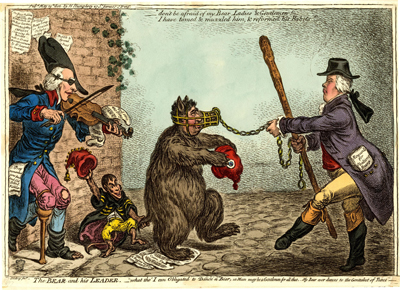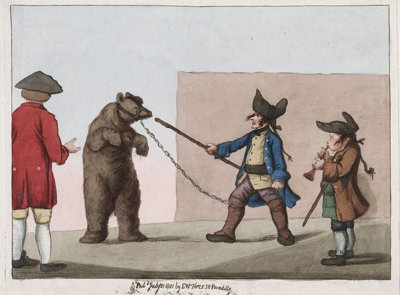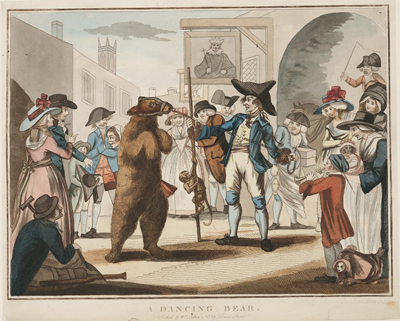The Bear and his Leader
This print appeared as the Ministry of all the Talents had to decide whether to make peace again with France, and it portrays Gillray's view of the ministry dynamics. The broad-bottomed Prime Minister William Grenville is depicted as the leader of a dancing bear troupe, including a bear, a fiddler, and a monkey. He carries in his pocket a box(?) labeled "Rewards for Obedient Bears" and a large staff inscribed "Cudgel For Disobedient Bears."
The dancing bear (on a very short leash) is Gillray's favorite target, the longtime Francophile and former leader of the Whig opposition, Charles James Fox, who had recently become Foreign Minister under Grenville's leadership. The fiddler is the erstwhile Prime Minister, Henry Addington, who, during his brief tenure as Britain's leader, had overseen the first peace with France, the Treaty of Amiens. He was now Lord Privy Seal. The monkey is the nephew of Lord Shelbourne, the diminutive Lord Henry Petty, now become Chancellor of the Exchequer.

© Trustees of the British Museum
Grenville is clearly orchestrating the dance steps for Fox and Petty—all raising their left legs in unison while Addington fiddles "God Save the King." Meanwhile, Grenville offers the following assurances to his audience:
—don't be afraid of my Bear, Ladies & Gentlemen.I have tamed & muzzled him & reformed his Habits.
The habits which require taming and muzzling are indicated by the songs now trampled under Fox's feet. One is "A Begging we will go" alluding to Fox's habits of incurring debts that have to be paid off by subscriptions (begging) from his friends. The other is the revolutionary anthem, Ca Ira, which together with the bonnets rouge on both Fox's and Petty's head, reminds us of the Whig's longtime advocacy for France. That advocacy was always perceived as, at least, foolish (the bonnet rouges are also fool's caps) and sometimes treasonous. Grenville purports to have those tendencies under control, but it impossible to say whether Fox and Petty have removed their caps for good or only temporarily.
On the wall behind the blind fiddler are several notices that satirize Addington and/or reinforce the theme of a beast tamed. "Bubble & Squeak—a Duet" refers to the nicknames of Addington's nephews for whom he procured widely-criticized sinecures while he was Prime Minister. "Pease Soup or Bruin's Delight, a Ballad" alludes to the Treaty of Amiens, one of Addington's signature accomplishments, which delighted the Foxite Whigs by fulfilling a long-standing goal of Peace/Pease with France. The last and largest notice amplifies what we see here: Orpheus (Grenville) charming the Brutes to an accompaniment by Dr. Sangrado, Gillray's satiric name for Addington whose father was a doctor. Sangrado was the name of a quack physician in LeSage's novel Gil Blas.
The caption comes from Act I Scene 2 of Oliver Goldsmith's She Stoops to Conquer where one of Tony Lumpkin's low drinking companions pretends to gentlemanliness, protesting that while he must dance a bear, he can still call himself a gentleman because his bear dances only to the most genteel of tunes. Applied to Grenville, this would suggest a protestation that in spite of an association with the bear (Fox), he is still operating in the best interests of the country, dancing to that most genteel of tunes, "God Save the King."
Bear baiting and bear dancing and were still around in the 18th and even into the 19th century. The following notice appeared in the June 1st edition of Bell's Weekly Messenger just a few weeks after Gillray's print was published:
At a bear-baiting on Tuesday in Tothill Fields, one of the bears, having broke loose, fastened upon a person by the name of Shawe whom he tore very much with his paws, and would have destroyed but for the assistance of the people.
With scenes like that still fresh in their minds, Gillray's audience would have recognized both the danger and the degree of control suggested by his dancing bear. And they might have remembered one of a couple of prints by Bunbury on the subject of bear dancing from the 1780s, one of which was reprinted by Fores in 1801.

© Lewis Walpole Library, Yale University

© Lewis Walpole Library, Yale University
Sources and Reading
- Commentary from the British Museum on The Bear and his Leader.
- "Pawing through the History of Bear Dancing in Europe," Bear Conservation
- "Henry Addington," Wikipedia
- "Charles James Fox," Wikipedia
- "William Grenville, 1st Baron Grenville," Wikipedia
- "Henry Petty-Fitzmaurice, 3rd Marquess of Lansdowne," Wikipedia
- Thomas Wright and R.H. Evans, Historical and Descriptive Account of the Caricatures of James Gillray #317.
- Thomas Wright and Joseph Grego, The Works of James Gillray, the Caricaturist; With the History of His Life and Times, p. 333.
Comments & Corrections
NOTE: Comments and/or corrections are always appreciated. To make that easier, I have included a form below that you can use. I promise never to share any of the info provided without your express permission.